|
Step By Step: Using Cracking Varnish To Create An Antique LookBy David KynastonThere's something romantic about an old sign. It's more than just the faded colors, the strange old alphabets, and slogans proclaiming the eternal usefulness of some long-forgotten gadget. "Entrance" signs make you wonder about the doors they marked; did some virtuoso musician stand next to that sign, waiting for a horse-drawn taxi, his instrument case tucked under his arm, his hat pulled low against the rain? And what about the one that says, "Carlo Vespucci, Milliner?" Was he the one who made your great-grandmother's favorite felt hat?We'll never know. Simple as that. We'll never know, but we'll always wonder, and we'll always like old signs for what they have to tell us about who we used to be. It's a fascination that connects all of us, whether we're sign painters or not. Old signs are interesting, and if you're a sign painter, they're fun to make. And besides being fun to make, signs that look old are a marketable item because of the special feel they can create. British sign artist David Kynaston knows how to make signs that look old. In the following step by step, David shows us the ins and outs of using cracking varnish and making faux antique signs that look like the real thing. Remember, it helps to look at some old signs before beginning this process. By familiarizing yourself with the way signs age, you'll be able to make a more convincing piece. Layout, color, and alphabet selection are a big part of making a sign look old. Study photographs of old signs to get a "feel" of the layout techniques used by the old-timers. "Antique" signs are great for interior decoration of pubs, clubs, restaurants, etc. Once you get a few in your portfolio, people will start asking for them. Most of all, they seem to be one of those sign effects which you've just got to try for yourself.
Step 1. The basic materials and tools are medium oak scumble glaze, clear non-polyurethane varnish (I use Sign Restoring Clear), water-based cracking varnish (I use French LeFranc and Bourgeois), black patina (also LeFranc & Bourgeois), a few rags, sandpaper, and a hair dryer. To make a medium oak scumble glaze, add one part raw linseed oil, one part varnish
(such as Sign Restoring Clear), and one part turps (or white spirit). To add a medium oak
tint to this clear glaze, add a little medium brown or tan 1-Shot to get the tint you
need. (Here in the U.K., I get these supplies at A.S. Handover, Ltd. You should be able to
get them from your local sign supplier.)
The best wood to use for theses signs is old planks. But you can use anything....stair
boards, driftwood, skirting, picture frames, or old signs.
Prime the sign panel. I primed this one with aluminum primer to seal the old wood, then
filled the entire surface. I don't usually do this; it just depends on the effect you
want. I followed the aluminum primer with white undercoat, then applied the gloss enamel.
I nearly always use a light color background because it makes the cracking effect more
noticeable.
After deciding on the design, sketch on the rough layout. Remember to choose letter
styles that are appropriate for the "old Sign"look.
Letter the sign. Don't use vinyl! I found this alphabet (Butcher's Roman) in the
March/April 1996 issue of SignCraft on page 102. Use higher contrasting colors and designs
than usual. Otherwise, they will be lost during the next few steps.
Gently rub over the design with a bit of wet or dry sandpaper or a Scotchbrite pad to
show lines of wear and tear. Then rub the entire surface with the Scotchbrite to dull the
sign for the next process.
Thin the scumble glaze approximately 50/50 and coat the entire surface with it, but with the very least possible amount. Pull it all over, leaving virtuall none in the center and a slightly heavier coating at the edges. The scumble is slow drying, so it gives you some time to work it, but you still have to work fast. Now get a glean brush, preferably a specially designed stippling brush, but an ordinary
2-in. to 3-in. hog hair brush will do. Hold the brush vertically and stipple the entire
surface to smooth out the brush stokes and give a smooth, agged effect. I made this
mistake of softening off the stipple effect after this process. This should be avoided as
the stippling adds to the overall finish considerably.
Age the sign further by adding more glaze in corners and along edges. By this stage, it
becomes apparent why sharp contrasts were used. When dry (after about 24 hours)' coat the
entire surface with oil-based non-polyurethane varnish. I use Sign Restoring Clear. After
applying the varnish, I waited about two hours (at 55degrees F), then I applied an even
coat of water-based cracking varnish. A rule of thumb is to leave the oil varnish to tack
up like gold size ready for gilding.
After about one hour, the cracks should begin to appear, but they won't be immediately
visible. Gently wave a hair dryer over the sign. This will speed up the drying process,
and the cracks will be slightly more visible. Allow the sign to dry thoroughly, lying flat
in a warm area. (The cracking varnish will become wet all over again if conditions are
damp.)
When the surface is completely dry, rub the black patina very gently over the entire
surface (or bit by bit) then buff off right away. The patina sits in the cracks and makes
them quite visible. This is when the sign really starts to look good. You can vary the
patina by polishing out more if you want fewer cracks to be visible.
Finally, seal the sign with a coat or two of oil-based varnish. I have found that gloss
varnish seems to make the colors appear richer.
He can be reached at 01978-823421 If you enjoyed this step by step, you're going to love having your own copy of SignCraft Magazine delivered right to your door 6 times a year. To recieve a free sample issue or subscribe right now just visit our website.[ Home
| Join Us!
|
Bulletin Board
|
Events |
Find A Letterhead
| Become A Resident
|
Letterville Merchants
]
|


 Step 2.
Step 2.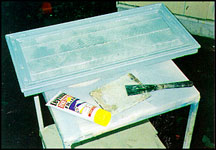 Step 3.
Step 3.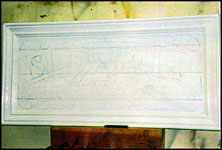 Step 4.
Step 4. Step 5.
Step 5. Step 6.
Step 6. Step 7.
Step 7.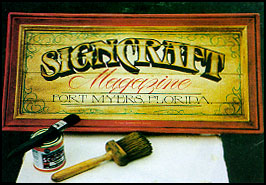 Step 8.
Step 8.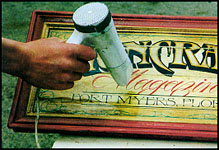 Step 9.
Step 9. Step 10.
Step 10.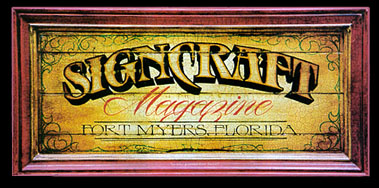 Step 11.
Step 11. Things To Remember....Keep these key points in mind as you tackle your first
antique sign, and all should go well:
Things To Remember....Keep these key points in mind as you tackle your first
antique sign, and all should go well:
 David Kynaston's shop, David Dynaston Signs, is in Llangollen, North Wales,
UK.
David Kynaston's shop, David Dynaston Signs, is in Llangollen, North Wales,
UK.